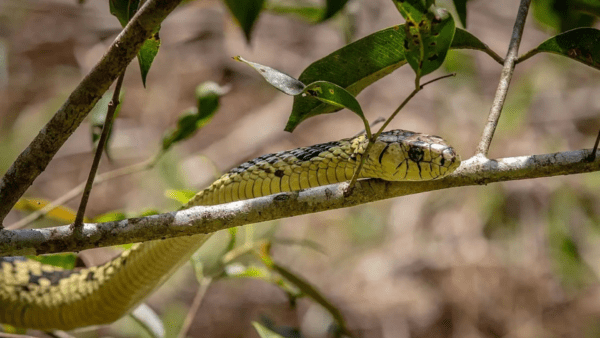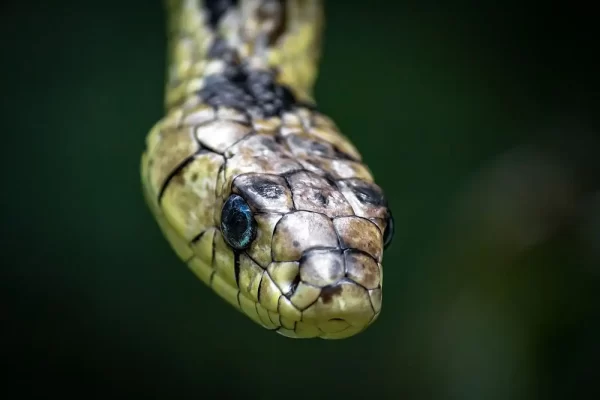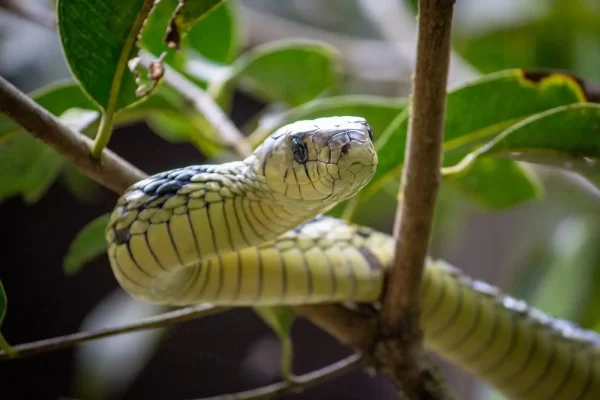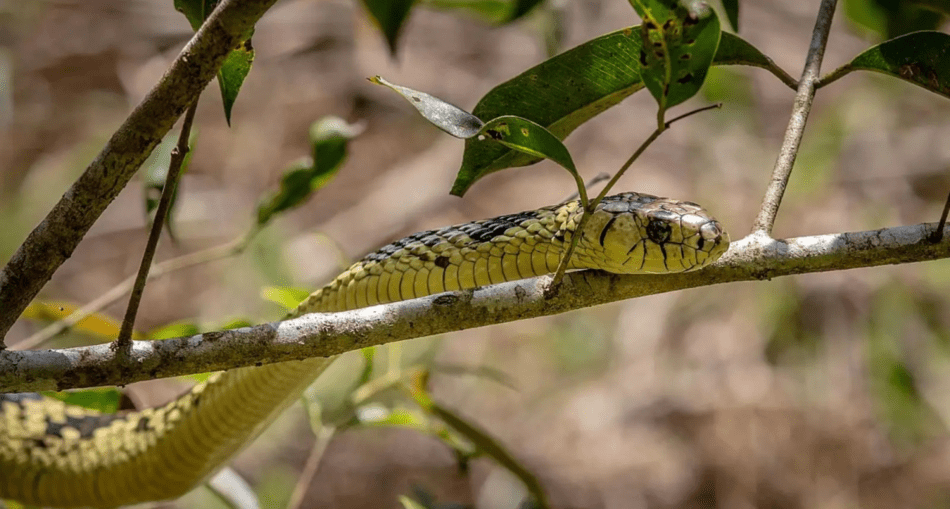The Spilotes pullatus, commonly known as the chicken snake, tropical chicken snake, or yellow rat snake, is a striking nonvenomous species native to the Neotropics.

The Chicken Snake [Photo: Luan Alves Chaves]
In Guyana, it is one of the most visually stunning reptiles that inhabits forested areas.
TAXONOMY AND SUBSPECIES
The Spilotes pullatus belongs to the colubrid family and has several recognised subspecies, each inhabiting different areas. These include:
- p. pullatus (Linnaeus, 1758)
- p. anomalepis (Bocourt, 1888)
- p. argusiformis (Amaral, 1929)
- p. maculatus (Amaral, 1929)
- p. mexicanus (Laurenti, 1768)
While these subspecies share similar traits, each exhibits unique variations that contribute to the snake’s wide geographical range and adaptability.
DESCRIPTION: A SNAKE WITH STUNNING COLOURATION
The Spilotes pullatus is renowned for its beautiful and distinctive coloration. The snake’s body is primarily black, adorned with yellow spots that may form crossbands along the length of its back.
The tip of its snout is also yellow, which adds to its dramatic appearance. Depending on the subspecies, the head shields may be mostly yellow, black, or a combination of both, with the sutures between the shields always being black.
Ventrally, the snake features a yellow underbelly with irregular black crossbands, further enhancing its visual appeal.
Adults can reach impressive lengths, often growing up to 2.7 meters (8.9 feet). The body is slender and somewhat laterally compressed, while the head is distinctly separated from the neck.

Photo: Luan Alves Chaves edited by Rodrigo Tetsuo Argenton
The eyes are moderate in size with a round pupil, and the snake’s scales are pointed and overlapping, which aids in its agility.
HABITAT AND DISTRIBUTION IN GUYANA
In Guyana, Spilotes pullatus primarily inhabits forested areas, especially those near water sources.
This snake thrives in tropical rainforests, where the dense canopy provides ideal conditions for its arboreal lifestyle.
Guyana’s rich biodiversity makes it an excellent habitat for these reptiles, as they are often spotted in trees, though they can also be found on the forest floor, hunting for prey.
While the chicken snake is native to much of South and Central America, including Guyana, it is considered a rare sight in urban areas, often dwelling in more secluded natural habitats.
Its ability to adapt to various environments, however, makes it a versatile species.
BEHAVIOUR: A DIURNAL HUNTER
The chicken snake is predominantly arboreal, meaning it spends most of its time in trees. However, it is also comfortable on the ground and is an excellent swimmer, often found near water sources.
As a diurnal predator, it is most active during the day, actively searching for prey both in the trees and on the forest floor.
Despite its relatively solitary nature, the Spilotes pullatus is known for its defensive aggression when threatened.
Its swift movements and ability to strike quickly make it a formidable predator, although its nonvenomous nature means it poses no threat to humans.

Photo: Luan Alves Chaves
DIET: CARNIVOROUS AND OPPORTUNISTIC
The Spilotes pullatus is a carnivorous snake, feeding on a wide variety of prey. Its diet includes small mammals, birds, lizards, amphibians, and eggs.
The snake is an opportunistic hunter. It often ambushed its prey by coiling around it or striking from above. It used its agility to capture and constrict its prey before swallowing it whole.
REPRODUCTION: EGG-LAYING SPECIES
Like many other snakes, the Spilotes pullatus is oviparous, meaning it lays eggs to reproduce. Female chicken snakes typically lay between 15 and 25 eggs, which they bury in secluded, humid areas to incubate.
Once hatched, the young snakes, known as “snakelets,” are independent and capable of fending for themselves.
REFERENCES







